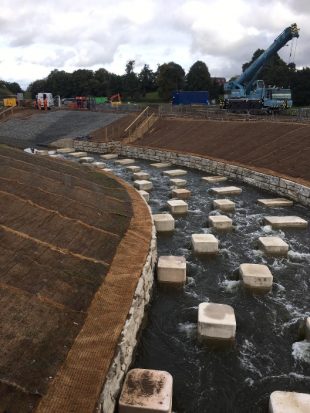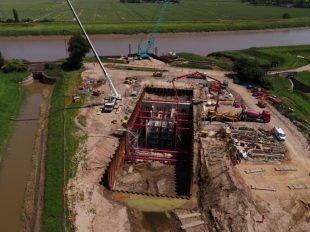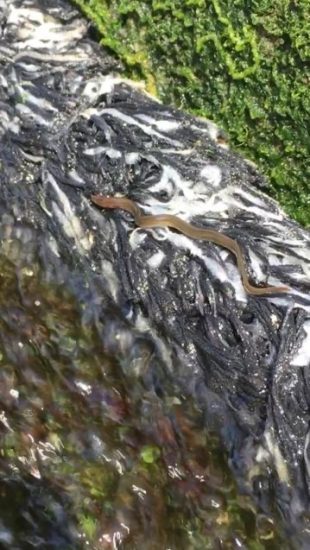This Saturday (24 October) is World Fish Migration day. In this blog, Sue Laver from the National Fisheries Services team writes about this global-local event which aims to create awareness of the importance of open rivers and migratory fish, and focuses on the ongoing work of the Environment Agency to open up more of England's rivers for fish passage.
A number of migratory fish species such as the European eel are critically endangered or threatened. One of the main causes are man-made barriers, weirs and sluices, which disrupt the natural flow of rivers and can prevent their usual migratory routes. Many fish need to migrate to reproduce, feed and complete their life cycles and here at the Environment Agency we work with many partner organisations across the UK to increase and improve the habitat available to our fish. Last year alone we completed 104 fish pass solutions and opened up or improved 1,058 kilometres of riverine habitats for fish.
 The Unlocking the Severn Project, which is supported by Senior Technical Specialist Charles Crundwell and is due for completion next year, will unlock more than 250 kilometres of the lowland River Severn. It is one of the largest whole river restoration projects ever attempted with the removal of obstructions and installations of 4 key fish passes. This will bring benefits to all fish species present and in particular the rare historically and culturally important twaite shad. Anglers, tourism and communities along the banks of the Severn all the way up to the Welsh border will also benefit.
The Unlocking the Severn Project, which is supported by Senior Technical Specialist Charles Crundwell and is due for completion next year, will unlock more than 250 kilometres of the lowland River Severn. It is one of the largest whole river restoration projects ever attempted with the removal of obstructions and installations of 4 key fish passes. This will bring benefits to all fish species present and in particular the rare historically and culturally important twaite shad. Anglers, tourism and communities along the banks of the Severn all the way up to the Welsh border will also benefit.
The first key pass at Bevere Weir has recently been completed. A 100 metre bypass channel with perturbation boulders to lower water velocities, will allow twaite shad to travel past Bevere towards their natural spawning grounds for the first time in 170 years. It’s actually quite a moving thought that these fish are now a step closer to the places they need to be but that have been denied to them.
Bevere pass (Unlocking the Severn)
On the other side of the country on the Great Ouse near King’s Lynn, a project is underway to build a new ‘fish friendly’ pumping station. Senior Technical Specialist for National Fisheries Services, Andy Don, has been involved in the planning and design of Islington Pumping Station, which will replace an aging asset owned and operated by King’s Lynn Internal Drainage Board (IDB). Andy’s involvement from early on ensured that that legislation designed to protect the critically endangered European eel was complied with and that safe passage for eels was considered throughout.
In order to protect eels, particularly at the intake and discharge points, ‘fish friendly’ pumps, pipework and operational aspects have been included in the design, enabling these creatures to travel through the station unhindered and unharmed. These features will protect adult eels leaving the river system on their journey to the Sargasso Sea, near Bermuda, where they spawn. Juvenile eels migrating up the Great Ouse from the Sargasso will be able to enter the river system due to a bespoke eel pass which will convey them around the pumping station allowing them to disperse into the wider catchment and grow.
This scheme is the largest IDB project currently underway with the Environment Agency as funding partner it is also the biggest contributor locally to the national target of 300,000 properties protected from flooding.
Islington Pumping Station construction (Kings Lynn IDB)
On a smaller scale, but no less important, we continue to monitor where and how fish move from place to place and work towards making their passage easier and more waterways accessible. One method we are trialling is the use of spat rope as a way of improving upstream eel passage at small weirs. The spat rope is a soft/fibrous material used in the aquaculture industry to grow mussels. It can be positioned at the edge of a weir away from the main flow of water and debris and can provide eels with the necessary conditions to successfully climb the weir. Initial testing has been promising and has showed that the rope is quickly found by migrating eels. It is intended that the rope can be used on many types of barriers including flow gauging weirs, where eel passage options are limited due to the effect on gauging accuracy. Ongoing testing will determine how effective the rope is in different situations.
to place and work towards making their passage easier and more waterways accessible. One method we are trialling is the use of spat rope as a way of improving upstream eel passage at small weirs. The spat rope is a soft/fibrous material used in the aquaculture industry to grow mussels. It can be positioned at the edge of a weir away from the main flow of water and debris and can provide eels with the necessary conditions to successfully climb the weir. Initial testing has been promising and has showed that the rope is quickly found by migrating eels. It is intended that the rope can be used on many types of barriers including flow gauging weirs, where eel passage options are limited due to the effect on gauging accuracy. Ongoing testing will determine how effective the rope is in different situations.
It makes me so proud to work alongside so many people that have such passion for fish and such commitment to enabling better passage for them. The challenge for us now is to continue with these great projects and more, continue working together in partnership to tackle the biggest challenges our fish species face and keep talking and sharing our stories. Globally, fish provide an important food supply and livelihood for millions of people around the world. They are ecologically, culturally, economically, and recreationally important! Because of this, we need to ensure the survival of these species for generations to come.
Sue Laver, National Fisheries Services team.
Find out more about World Fish Migration Day

Leave a comment